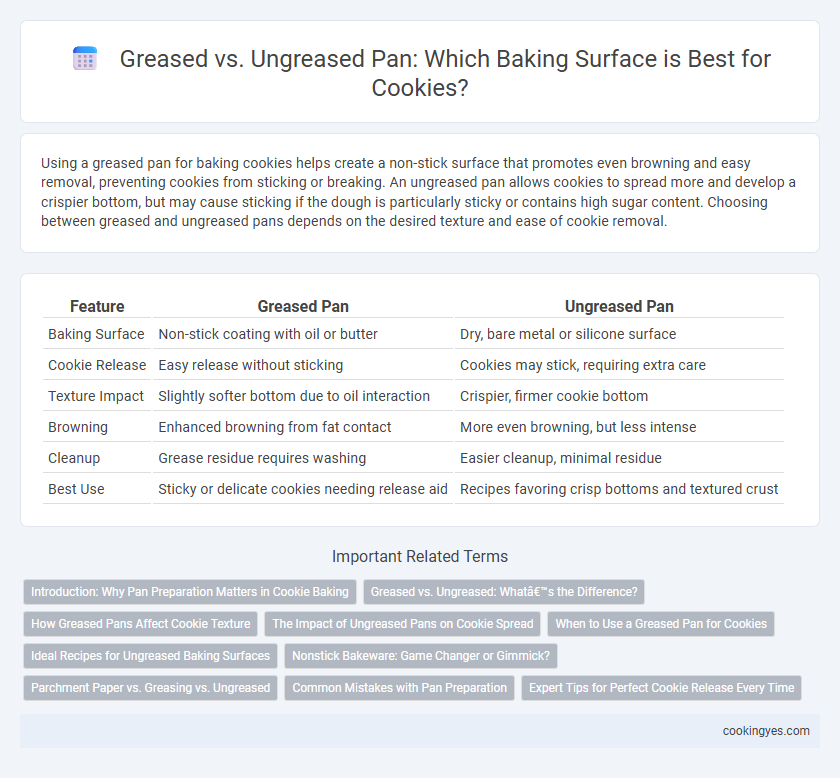Using a greased pan for baking cookies helps create a non-stick surface that promotes even browning and easy removal, preventing cookies from sticking or breaking. An ungreased pan allows cookies to spread more and develop a crispier bottom, but may cause sticking if the dough is particularly sticky or contains high sugar content. Choosing between greased and ungreased pans depends on the desired texture and ease of cookie removal.
Table of Comparison
| Feature | Greased Pan | Ungreased Pan |
|---|---|---|
| Baking Surface | Non-stick coating with oil or butter | Dry, bare metal or silicone surface |
| Cookie Release | Easy release without sticking | Cookies may stick, requiring extra care |
| Texture Impact | Slightly softer bottom due to oil interaction | Crispier, firmer cookie bottom |
| Browning | Enhanced browning from fat contact | More even browning, but less intense |
| Cleanup | Grease residue requires washing | Easier cleanup, minimal residue |
| Best Use | Sticky or delicate cookies needing release aid | Recipes favoring crisp bottoms and textured crust |
Introduction: Why Pan Preparation Matters in Cookie Baking
Pan preparation significantly impacts cookie texture and evenness during baking. Using a greased pan promotes a tender, golden-brown crust by facilitating heat distribution and preventing sticking. An ungreased pan yields a crisper edge and allows cookies to spread naturally, enhancing air circulation for uniform baking.
Greased vs. Ungreased: What’s the Difference?
Greased pans create a non-stick surface by coating the baking area with fats like butter or oil, preventing cookies from sticking and promoting even browning; ungreeased pans rely on the natural surface, often resulting in crispier edges but potential sticking issues. Using a greased pan adds slight moisture to the cookie's base, enhancing softness, whereas an ungreased pan typically produces cookies with a firmer, crisper bottom. Texture and release depend on pan type and dough composition, making greasing a key factor in achieving desired cookie outcomes.
How Greased Pans Affect Cookie Texture
Greasing a pan creates a slick surface that often results in cookies with a crisper bottom and edges due to enhanced heat conduction and reduced sticking. In contrast, an ungreased pan can produce cookies with a chewier texture and a slightly matte finish since the dough spreads less and adheres more during baking. The choice between greased and ungreased pans directly influences moisture retention, browning, and overall cookie texture.
The Impact of Ungreased Pans on Cookie Spread
Ungreased pans create a dry surface that limits cookie spread by preventing the dough from sliding freely during baking, often resulting in thicker, puffier cookies. The absence of grease increases friction, causing cookies to rise more vertically rather than spreading outward. This effect is particularly noticeable in recipes with higher butter content, as the dough's natural oils cannot counterbalance the pan's stickiness.
When to Use a Greased Pan for Cookies
Use a greased pan for cookies that require a crispier bottom and easier release, such as sugar cookies or butter cookies. Greasing the baking surface helps prevent sticking and promotes even browning by creating a slight barrier between the dough and the pan. Avoid greasing for cookies that are meant to spread thin or have a chewy texture, as an ungreased surface can enhance crispness and structure.
Ideal Recipes for Ungreased Baking Surfaces
Ungreased baking surfaces are ideal for recipes that rely on crisp edges and uniform browning, such as sugar cookies and shortbread, which benefit from direct contact with the pan's heat. Recipes with high fat content in the dough, like peanut butter cookies, naturally release easily without sticking, making a greased pan unnecessary. Avoid using ungreased pans for sticky, wet doughs like chocolate chip cookies, which require a non-stick layer to prevent tearing or burning on the baking surface.
Nonstick Bakeware: Game Changer or Gimmick?
Nonstick bakeware significantly reduces the need for greasing pans, offering a convenient, healthier baking surface that prevents cookie dough from sticking and ensures even browning. Using a greased pan with nonstick bakeware can cause uneven cooking and greasy textures, while an ungreased nonstick pan maintains the cookie's crisp edges and soft centers. Consumer reviews and baking tests consistently show nonstick surfaces improve release and cleanup, making them a game changer for home bakers aiming for perfect cookies every time.
Parchment Paper vs. Greasing vs. Ungreased
Parchment paper provides a non-stick surface that eliminates the need for greasing, ensuring cookies bake evenly without spreading excessively. Greasing a pan can enhance browning and crisp edges but may cause cookies to spread too thin or stick if overapplied. An ungreased pan relies on proper dough consistency and often results in more controlled cookie shape but risks sticking, especially without the protective layer that parchment paper offers.
Common Mistakes with Pan Preparation
Using a greased pan instead of an ungreased pan for baking cookies often leads to uneven spreading and overly crispy edges due to excessive oil preventing proper dough rise. Common mistakes include applying too much butter or oil, which can cause cookies to flatten and brown too quickly, altering texture and taste. Conversely, neglecting to grease a pan when required results in sticking, breaking, and uneven baking, especially with sticky cookie dough types.
Expert Tips for Perfect Cookie Release Every Time
Using a greased pan creates a thin, non-stick barrier that helps cookies release easily without breaking, especially for buttery or delicate doughs. Ungreased pans promote a crisper, more textured cookie bottom by allowing direct heat contact but may require parchment paper or silicone mats to prevent sticking. Expert bakers recommend greasing for softer cookies and leaving pans ungreased or lined for chewier, crisper batches to achieve the perfect cookie texture and release every time.
Greased Pan vs Ungreased Pan for Baking Surface Infographic

 cookingyes.com
cookingyes.com